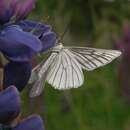Biology
provided by Arkive
The adults are on the wing in May and June and are largely crepuscular (7). They rest in long grasses during the day from which they are easily disturbed, sometimes flying naturally on warm, dull days (8). Caterpillars hatch from the eggs laid by the adults; they are present from July to May and hibernate through the winter, emerging the following spring when they pupate (2). The adults then emerge, starting the cycle again. This type of lifecycle is known as 'single brooded' or 'univoltine', as only one generation (or 'brood') is produced in the year.
Conservation
provided by Arkive
The Species Action Plan produced as part of the UK Biodiversity Action Plan aims to maintain all current populations and restore a further ten populations in the historic range before 2010 (1). Since 1995, an English Nature Species Recovery Programme has worked towards meeting these aims (1).
Description
provided by Arkive
Adult Black-veined moths are white in colour with black veins that are more obvious on the underside of the wings. Females differ from males in that they have slightly shorter wings and thicker, shorter bodies (3). The caterpillars are grey-brown in colour with darker lines along the back and sides (3).
Habitat
provided by Arkive
This moth inhabits lowland calcareous grasslands dominated by tor-grass (Brachypodium pinnatum) where the main larval foodplant marjoram (Origanum vulgare) is present within the sward (1).
Range
provided by Arkive
This species was once known from Kent, Dorset, Sussex, Essex, and Somerset, but now remains in just four sites in Kent (1). It has a wide distribution in Europe and extends as far east as Siberia (1).
Status
provided by Arkive
Classified as Endangered in Great Britain and fully protected under Schedule 5 of the Wildlife and Countryside Act 1981 (6).
Threats
provided by Arkive
It is thought that the drastic decline of the Black-veined moth is the result of habitat burning, whether accidental or deliberate, over-grazing and lack of suitable management leading to scrub encroachment (1). The reason for the habitat management requirements of Siona lineata, and the probable cause of the contraction of its range, is the species' requirement for transitional calcareous grassland within a specific stage of succession. The required habitat must exhibit a well-developed sward-mosaic of grass tussocks and herb growth, of sufficient length to offer protection to larvae throughout the winter. In the past, Siona lineata was doubtless able to find alternative suitable breeding habitat when an existing site became overgrown, cultivated or otherwise unsuitable. This is no longer the case, and the maintenance of suitable habitat at existing colony sites must remain the priority (7).
Siona lineata
provided by wikipedia EN
Siona lineata, the black-veined moth, is a moth of the family Geometridae. The species was first described by Giovanni Antonio Scopoli in his 1763 Entomologia Carniolica.[1]
Subspecies
Subspecies include:[2]
-
Siona lineata lineata (Scopoli, 1763)
-
Siona lineata oenotriensis (Staudinger, 1915)
Distribution
This rather common species can be found throughout Europe.[3] It is quite rare in the United Kingdom,[4] only being found in east Kent.[5] It is also present in the Amur and Ussuri Regions, southern Siberia, central Asia, Kazakhstan, Caucasus, Asia Minor and Russia.[4]
Habitat
These moths inhabit limestone and chalk grassland, rough downland, open woodlands, pastures and grassy areas.[6][7]
Description
The wingspan is 35–40 mm.[6] Wings are white or cream coloured with dusky veins in the upperside and black or dark brown veins on the underside.[7] The underside of the wings usually shows also a blackish transverse stripe beyond the middle, very faint in the hindwings. Fresh butterflies are usually cream coloured, but as they get older, the wings are becoming whiter. With the disappearance of the scales the black veins on the undersides become increasingly visible on the uppersides through the wings.[8]
The head is small, with large and globose lateral eyes. Legs are long and slender. The males have a long slender abdomen with a curved upward end, while in the females the abdomen is stouter and not curved. The females are also smaller and with more angular wings. In the females the abdomen has three longitudinal black lines.[8]
Biology
The moth flies during the day in one generation from the beginning of May to the end of June [1]. The caterpillar feeds on various herbs, (Origanum majorana, Dactylis glomerata, Hypericum maculatum, Vicia species, Galium verum, Solidago virgaurea, Achillea millefolium, Tanacetum vulgare), and woody plants (Salix aurita, Viburnum opulus).[6][9][10] The species overwinters as half-grown caterpillar and then pupates in a cocoon attached to a grass blade, or a plant stem.[8]
Gallery
Notes
-
^ The flight season refers to Belgium and The Netherlands. This may vary in other parts of the range.
References

- license
- cc-by-sa-3.0
- copyright
- Wikipedia authors and editors
Siona lineata: Brief Summary
provided by wikipedia EN
Siona lineata, the black-veined moth, is a moth of the family Geometridae. The species was first described by Giovanni Antonio Scopoli in his 1763 Entomologia Carniolica.
- license
- cc-by-sa-3.0
- copyright
- Wikipedia authors and editors

